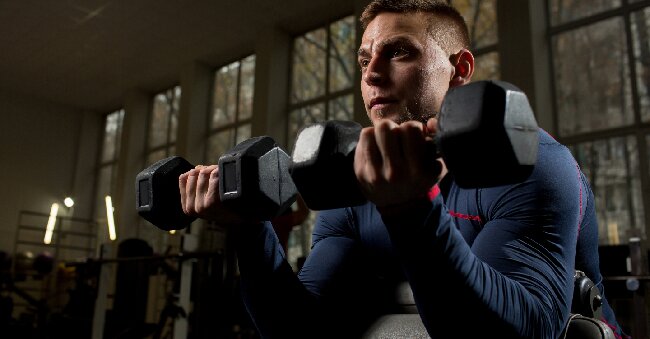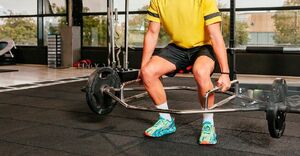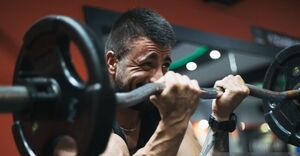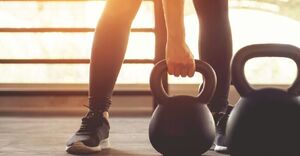
Quick Start for Dumbbell Beginners: 30-Minute Full-Body Training Strategy
Are you new to using dumbbells for your workouts? Or maybe you’re looking for a quick and effective full-body training strategy?
In this article, we’ll explore everything you need to know about dumbbells – from what they are and why they’re great for training, to how to choose the right ones for you.
We’ll also discuss the benefits of a 30-minute full-body dumbbell training routine, essential exercises, and even provide you with a sample workout routine to get you started.
Whether you’re a beginner or looking to switch-up your routine, we’ve got you covered!
What Are Dumbbells?
Dumbbells are a type of free weights commonly used in strength training and fitness exercises to build muscle and improve overall physical strength and endurance.
Dumbbells are available in different weights, making them suitable for various training methods like bodybuilding, circuit training, and HIIT workouts. These functional movements engage multiple muscle groups, promoting balance and stability while reducing the risk of muscular imbalances.
From simple curls to compound exercises like lunges and presses, dumbbells offer a diverse range of options to target specific muscle groups and achieve progressive overload for long-term strength gains. Whether you’re looking to tone, bulk up, or rehabilitate, dumbbells are a must-have tool in any fitness enthusiast’s arsenal.
Why Use Dumbbells for Training?
Dumbbells are an excellent choice for training due to their versatility, allowing for a wide range of exercises targeting different muscle groups. This makes them suitable for both gym and home workouts.
Dumbbells offer the flexibility to adjust weight based on strength and skill level, making them suitable for both beginners and advanced athletes. Their convenience for home workouts is unmatched, taking up minimal space and easy to store.
Not only do dumbbells play a significant role in promoting strength and fitness, but they also engage stabilizing muscles, improve coordination, and contribute to overall muscle development. Incorporating them into a workout regimen can lead to increased muscle mass, improved bone density, and enhanced functional fitness.
How to Choose the Right Dumbbells for You?
Choosing the right dumbbells involves considering factors such as your fitness level, training goals, and the suitability of the weights for your preferred exercises, especially for beginners or those focusing on home workouts.
For beginners, it’s important to begin with lighter weights to prevent strain and injury. A good starting point for those new to strength training is selecting dumbbells weighing around 5-10 pounds.
For more experienced individuals, the weight choice will vary depending on their specific training goals. Those looking to build muscle and increase strength may need heavier dumbbells, while those focusing on toning and endurance may benefit from lighter weights. Remember to listen to your body and gradually increase weight as your strength and confidence improve.
What Weight Should I Start With?
For beginners, it’s crucial to start with lighter dumbbells to ensure proper technique and form. This gradual approach helps develop a solid foundation and prevents injury during strength training exercises.
As beginners progress and improve, they can gradually increase the weight to continue challenging their muscles. It’s important to maintain good form and posture throughout the exercises to protect against injury and maximize effectiveness.
By selecting the right starting weight, beginners set themselves up for a safe and productive strength training experience.
What Are the Different Types of Dumbbells?
Dumbbells come in various types including adjustable, fixed, and selectorized, each catering to specific training strategies and preferences, suitable for both gym and home workout settings.
Adjustable dumbbells offer versatility and convenience, allowing users to change weights easily by adding or removing plates. This makes them ideal for strength training and progressive overload.
On the other hand, fixed dumbbells are durable and require minimal maintenance. They are perfect for isolation exercises and targeting specific muscles.
For those looking for a space-saving option, selectorized dumbbells are a great choice. With a simple twist or turn, users can quickly adjust the weight, making them suitable for circuit training and high-intensity workouts.
What Are the Benefits of a 30-Minute Full-Body Dumbbell Training?
A 30-minute full-body dumbbell training routine offers a time-efficient workout that combines strength training and cardiovascular benefits, promoting muscle growth, fat burning, and overall fitness improvement.
These workouts target multiple muscle groups simultaneously, leading to a higher calorie burn and increased metabolism. They also improve functional strength, enhancing daily activities and reducing the risk of injury.
The use of dumbbells allows for a wide variety of exercises, including squats, lunges, presses, and rows, providing a well-rounded full-body workout. The short duration of the routine makes it easily achievable for individuals with busy schedules, ensuring consistent fitness progress without taking up too much time.
Saves Time
A 30-minute full-body dumbbell workout saves time while providing a comprehensive exercise routine that targets major muscle groups, making it an efficient option for individuals with busy schedules.
This focused workout plan integrates compound movements, allowing for a holistic approach to strength training.
By engaging multiple muscle groups simultaneously, individuals can efficiently progress through the workout, optimizing their time spent without sacrificing the intensity of the session.
With strategic time management, these routines accommodate the hectic schedules of modern life while still promoting significant fitness gains.
The adaptability of such workouts makes it easier for individuals to prioritize their physical well-being amidst various commitments, maintaining a balanced approach to overall health and time utilization.
Builds Muscle and Strength
A full-body dumbbell workout promotes muscle development and overall strength through targeted exercises that engage multiple muscle groups, offering a comprehensive strength training session.
These exercises not only enhance muscular endurance and definition but also improve functional strength, making everyday tasks easier.
Incorporating dumbbells into a full-body workout allows for constant muscle engagement and balance, leading to increased stability and coordination.
By including exercises such as squats, lunges, rows, and presses, individuals can effectively build muscle mass and strength while also improving joint stability and flexibility.
This comprehensive approach to strength training helps individuals achieve a well-rounded, balanced physique.
Improves Cardiovascular Health
Incorporating cardiovascular exercises in a full-body dumbbell workout enhances heart health, endurance, and overall cardiovascular fitness, providing a holistic approach to physical activity and exercise.
This type of workout engages multiple muscle groups, stimulating the heart to pump blood more efficiently and improving oxygen delivery throughout the body.
It also strengthens the cardiovascular system, with benefits including reduced risk of heart disease, lower blood pressure, and increased stamina. As a result, regular participation in these exercises can contribute to better overall health and well-being, making them an essential component of a well-rounded fitness routine.
Burns More Calories
A full-body dumbbell routine involving both strength and cardiovascular exercises contributes to calorie burning and weight management, making it an effective option for individuals aiming to shed excess body fat and improve overall fitness.
This type of workout engages multiple muscle groups simultaneously, resulting in higher calorie expenditure and improved metabolism. By incorporating compound movements, such as squats, lunges, and presses, it elevates heart rate, providing a cardiovascular challenge.
The intensity of the workout can be adjusted by varying the weight of the dumbbells and the number of repetitions, allowing individuals to tailor the workout to their fitness level and goals. The incorporation of dynamic movements helps to enhance coordination, balance, and functional strength, contributing to comprehensive fitness training.
What Are the Essential Dumbbell Exercises for a Full-Body Workout?
Key dumbbell exercises for a full-body workout include squats, chest press, rows, shoulder press, bicep curls, tricep extensions, lunges, and deadlifts. These exercises target major muscle groups and provide a comprehensive strength training regimen.
They are integral to building overall body strength and enhancing muscular endurance.
Squats effectively work the quadriceps, hamstrings, and glutes, while chest press targets the pectoral muscles and triceps.
Rows engage the back, biceps, and shoulders, contributing to a balanced upper body.
Shoulder press focuses on the deltoid muscles, promoting shoulder stability.
Bicep curls stimulate the biceps and forearms, while tricep extensions isolate and strengthen the triceps.
Lunges engage the quadriceps and glutes, aiding lower body strength, and deadlifts work the hamstrings, glutes, and lower back, fostering functional strength.
Dumbbell Squats
Dumbbell squats are a fundamental full-body exercise that targets the lower body and core. This promotes leg strength, muscle development, and overall stability through effective squatting technique with dumbbells.
By adding dumbbells to the traditional squat, you increase the resistance, which helps in building muscle mass, increasing lower body strength, and improving overall functional fitness.
Engaging in proper form is crucial for preventing injury and maximizing the benefits of this exercise. To perform a dumbbell squat, stand with feet shoulder-width apart, holding a dumbbell in each hand. Lower your body by bending your knees and hips, keeping your back straight and chest upright. Push through your heels and return to the starting position. This exercise engages the quadriceps, hamstrings, glutes, and core, offering a comprehensive lower body workout.
Dumbbell Chest Press
The dumbbell chest press is a key exercise for comprehensive upper body strength and muscle development. It targets the chest, shoulders, and arms, promoting effective pressing movements with dumbbells.
The dumbbell chest press is a great exercise for engaging multiple muscle groups at once. It helps build a well-rounded physique and should be done with proper form to ensure optimal muscle engagement and prevent injury. Keep your movements stable and controlled throughout the exercise to maximize the benefits for your chest, shoulders, and triceps. This makes it a crucial addition to any upper body workout routine.
What’s great about the dumbbell chest press is its versatility. You can vary your grip and angle to target different areas of the chest and shoulders, providing a well-rounded workout for these muscle groups.
Dumbbell Rows
Dumbbell rows are essential for back and arm development. This exercise focuses on promoting proper rowing movements with dumbbells to engage the back muscles, biceps, and forearms effectively.
Incorporating dumbbell rows into your workout routine can effectively target key muscle groups. These include the latissimus dorsi, rhomboids, and trapezius. This can lead to improved posture and overall back strength.
Proper form is essential when performing dumbbell rows. This helps minimize the risk of injury and maximize muscle activation. It’s important to maintain a stable core and avoid using excessive momentum. Instead, allow for a controlled movement from the starting position to the fully contracted position.
This exercise not only enhances back and arm strength but also contributes to a well-rounded upper body workout.
Dumbbell Shoulder Press
The dumbbell shoulder press is a crucial exercise for upper body strength and shoulder development. It involves effective pressing movements with dumbbells to engage the deltoid muscles and promote shoulder stability.
This exercise not only targets the deltoids but also engages the trapezius, triceps, and upper chest, contributing to a well-rounded upper body workout.
Proper form is essential, maintaining a straight back, keeping the core engaged, and controlling the movement to avoid strain.
Incorporating variation in grip width can help to emphasize different parts of the shoulders and ensure balanced muscle development.
Consistent inclusion of dumbbell shoulder presses in a workout routine can enhance overall shoulder strength and stability, promoting better posture and functional strength in daily activities.
Dumbbell Bicep Curls
Dumbbell bicep curls are essential for arm and bicep development. They focus on promoting proper curling movements with dumbbells to engage and strengthen the biceps and forearms effectively.
When performing dumbbell bicep curls, it is important to maintain proper form and control throughout the exercise. This maximizes its benefits by utilizing a full range of motion, ensuring the biceps are fully engaged for muscle growth and strength.
Incorporating dumbbell bicep curls into your workout routine can help improve overall arm strength and stability. This can contribute to better performance in various activities and sports. Remember to start with a weight that allows for proper form and gradually increase the resistance as your strength improves.
Dumbbell Tricep Extensions
Dumbbell tricep extensions are crucial for tricep development and arm strength. This exercise involves effective extension movements with dumbbells to engage and strengthen the triceps and promote overall arm stability.
This exercise is beneficial for individuals looking to enhance their arm strength and sculpt their triceps. By performing tricep extensions with dumbbells, individuals can isolate and target the triceps, leading to increased muscle activation and growth.
Proper form is essential, ensuring that the elbows remain stable and close to the head throughout the extension to maximize tricep engagement. Incorporating this exercise into a comprehensive arm workout routine can contribute to improved overall upper body strength and stability.
Dumbbell Lunges
Dumbbell lunges are essential for lower body strength and stability. This exercise targets the legs and core, involving proper lunging movements with dumbbells to engage the quadriceps, glutes, and promote overall lower body stability.
This exercise is highly effective in building leg strength and muscle endurance while also enhancing balance and coordination. By incorporating dumbbells into lunges, individuals can intensify the workout, leading to greater muscle engagement.
To execute a proper dumbbell lunge, stand upright with dumbbells in each hand, take a large step forward, allowing both knees to bend at a 90-degree angle, and then return to the starting position. This movement enhances muscle activation and aids in developing functional lower body strength. By adhering to correct form and technique, individuals can fully optimize the benefits of dumbbell lunges while minimizing the risk of injury.
Dumbbell Deadlifts
Dumbbell deadlifts are crucial for comprehensive strength and muscle development. This exercise targets the lower body and core, involving effective lifting movements with dumbbells to engage the hamstrings, glutes, and promote overall stability and strength.
This exercise is especially beneficial for improving lower body strength and posture. By maintaining proper form and technique during dumbbell deadlifts, individuals can enhance their muscle endurance and build powerful glutes and hamstrings.
Engaging the core and focusing on hip hinge movements also aids in developing a strong and stable lower back. The controlled nature of this exercise allows for increased muscle engagement and reduced risk of injury when performed correctly. It’s essential to ensure the dumbbells are lifted in a smooth and controlled motion, maintaining a neutral spine and avoiding rounding of the back.
What Is a Sample 30-Minute Full-Body Dumbbell Training Routine?
A sample 30-minute full-body dumbbell training routine typically includes a warm-up session, the main workout comprising various exercises, and a cool-down and stretching phase to ensure proper recovery and muscle relaxation.
For the warm-up, it’s recommended to start with 5-10 minutes of light cardio. This can include activities like jogging in place or doing jumping jacks. This will help elevate your heart rate and prepare your muscles for the upcoming exercises.
Moving on to the main workout, there are various popular exercises you can do. These include dumbbell squats, lunges, chest presses, and bent-over rows. These exercises engage multiple muscle groups and can help you achieve a full-body workout. Aim for 3 sets of 10-12 reps for each exercise, with a minute of rest in between.
For the cool-down, it’s important to focus on gentle stretching and deep breathing. This can help reduce muscle soreness and promote flexibility. Take a few minutes to stretch out your muscles and focus on your breathing to end your workout on a calming note.
Warm-up (5 minutes)
The warm-up phase of a 30-minute full-body dumbbell training routine focuses on preparing the body for exercise, enhancing flexibility, and gradually increasing endurance through light physical activity and stretching.
This phase is crucial for optimizing the benefits of the upcoming workout. By increasing blood flow to the muscles, the warm-up helps to reduce the risk of injury and improve overall performance.
Incorporating dynamic stretches like arm circles, leg swings, and torso twists can enhance flexibility and range of motion. Engaging in low-impact cardio exercises, such as jogging in place or jumping jacks, aids in raising the heart rate gradually, thus preparing the body for more intense physical activity.
This thorough warm-up routine primes the body for a successful and effective dumbbell training session.
Main Workout (20 minutes)
The main workout segment of a 30-minute full-body dumbbell training routine involves a series of exercises targeting different muscle groups with specific reps, sets, and exercise intensity, emphasizing proper form and control throughout the session.
Each exercise in this segment is carefully chosen to maximize the efficiency of the workout. From squats and lunges for lower body strength to bicep curls and shoulder presses for upper body toning, the routine covers a wide range of movements.
Each exercise is performed for around 10-12 reps with 2-3 sets to ensure thorough muscle engagement. The exercise intensity is moderate to high, with short rest intervals between sets to keep the heart rate up and promote calorie burn. This combination of variety, rep and set structure, and intensity delivers a well-rounded and effective full-body workout.
Cool Down and Stretch (5 minutes)
The cool-down and stretching phase of a 30-minute full-body dumbbell training routine focuses on aiding muscle recovery, promoting flexibility, and ensuring a gradual transition into a resting state after the workout.
This phase is critical for allowing the heart rate to gradually return to its normal pace, which helps prevent lightheadedness and dizziness.
Stretching post-workout helps to maintain and improve the flexibility of the muscles, reducing the risk of injury from future training sessions.
Incorporating static and dynamic stretches targeting all major muscle groups can alleviate post-exercise stiffness and soreness, enhancing overall relaxation and recovery.
It’s important to remember that cooling down and stretching are just as crucial as the main workout for holistic fitness benefits and long-term wellness.




No Comments